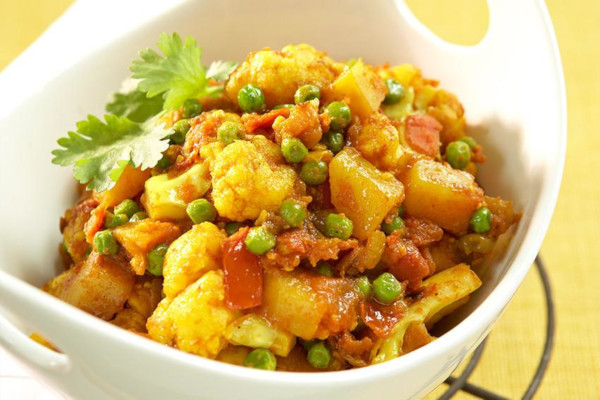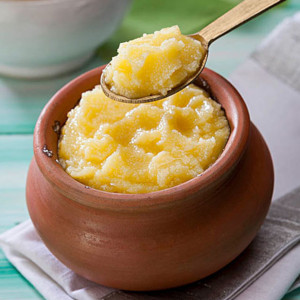“What, in the name of all that’s culinary, is Ghee?” I hear you saying. In its simplest form, it’s just Clarified Butter. But some of you are now saying, “Clarified? Huh?” So, let’s take a quick trip to India and discover what the stuff is used for, why it’s so highly prized and how it’s made…
 Aloo Gobi: A classic Veggie main dish from India featuring Potatoes and
Aloo Gobi: A classic Veggie main dish from India featuring Potatoes and
Cauliflower. Preparation starts – as with many, many Asian dishes –
with the toasting of Spices and sautéing of Vegetables in Ghee.
You’ll find Ghee in every Asian grocery store. It’s a kitchen staple across the Far East and in other countries scattered around the world. Why haven’t we heard (much) about it here in the West? Because we have other cooking Fats and Oils that are traditional to our way of doing things.
What, exactly, is it?
Classic Ghee is Water Buffalo Butter that’s simmered to render the fat from the Water and solids. When the Water is completely evaporated and the Milk Solids have precipitated to the bottom of the simmering vessel or risen to the top to be skimmed, the clear Butter Oil is poured off and saved. This is what we commonly call Clarified Butter. Ghee is a particular type of Clarified Butter which is made from Cultured Milk. The flavour is unique.
Why Clarified Butter?
Ghee and regular Clarified Butter (Butter Oil) have flavours that no other cooking Fat or Oil can match. And their ability to take high heat without smoking (burning) is highly valued throughout the culinary world. Clarified Butter can, in fact, be heated to 480 F / 250 C before its molecules start to break down. That’s considerably higher than the usual Deep Frying temperature of around 365 F / 185 C, using Vegetable Oil.
As for the flavour, serious Asian cooks insist you can’t make a proper Curry without Ghee. How many times have you wondered why, try as you might, your home-made Curries just couldn’t match those from your favourite Asian Restaurant?
Using Clarified Butter
You can use Clarified Butter anywhere you would normally use Canola, Corn or Vegetable Oil. But, whereas the latter Oils are prized at least in part for their neutral taste, Clarified Butter will impart a nutty flavour. Clarified Butter is, as we said earlier, ideal for frying and Stir Frying in particular. At very high temperatures, foods cut thinly will cook almost instantly retaining their colours and flavours, and crusted foods will develop perfect crispness and toasted colour.
Clarified Butter is also great for brushing Pastry to produce a golden brown, nutty finish.
Prepared Clarified Butters usually come from the store in air tight glass bottles. You can leave the product out on the kitchen counter or in the cupboard for up to 3 months, but I prefer to refrigerate it. Like any highly saturated fat, it will congeal, but it’s easy to scoop out a spoonful when you want it, and the Oil will liquefy again quickly under the influence of heat.
Just the fact’s, Ma’am…
Clarified Butter / Ghee is almost pure Fat (99.5 percent) of which about two-thirds is Saturated Fat and one third is Unsaturated. Transfats make up only a very small percentage of Clarified Butter (about 4 percent). But 3.5 oz. / 100 g of Clarified Butter contains 256 mg of Cholesterol – 85 percent of your recommended daily intake. On the plus side, Clarified Butter is a great source of vitamins A and E. And, considering that you’ll use only about 1 tbsp. / 15 g at a time for pan frying a dish to be consumed by the whole family, the stuff adds up pretty healthy – except for the Saturated Fat, of course. Overall, Ghee / Clarified Butter is no more unhealthy than regular Butter.
So why not experiment with clarified Butter? Find out what you’ve been missing!
~ Maggie J.

